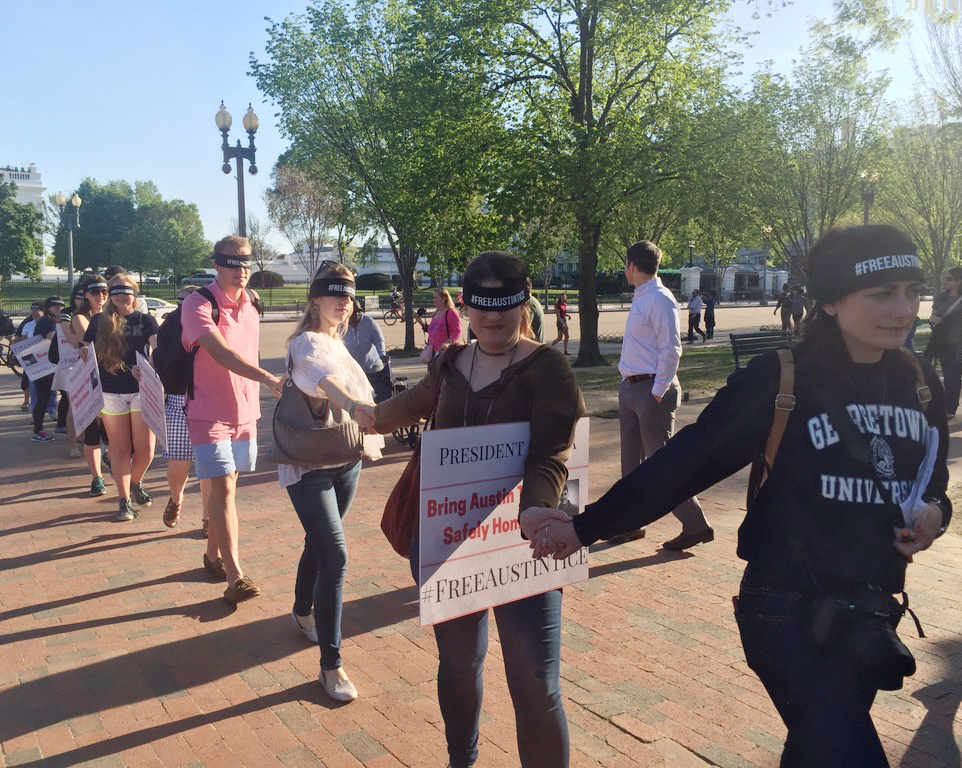
In a rally organized by the Georgetown undergraduate journalism program, students gathered to demand that President Obama negotiate for Austin Tice’s release.
Georgetown students and other activists demonstrated outside the White House on Monday evening in an effort to pressure President Barack Obama to negotiate freedom for journalist Austin Tice (SFS ’02), who disappeared in Syria in 2012.
Tice, a former Georgetown law student and Marine Corps veteran, went missing in Syria on Aug. 12, 2012, while working as a freelance journalist covering the conflict there for McClatchy Newspapers, The Washington Post, CBS and other media outlets. It is believed that Tice is currently being held captive in the Middle East.
Georgetown Law Center students and Reporters Without Borders representatives joined 10 undergraduate protestors who wore black blindfolds with the phrase “#FREEAUSTINTICE” and carried posters reading “President Obama, we are counting on you,” “Finish strong; bring Austin safely home” and “Without journalists, we are all deprived of information, we are all blindfolded.” The protestors asked Obama’s administration to make Tice’s release a priority before the president’s term ends.
The protestors also had a list of 23 additional student supporters who were unable to attend the rally.
The Georgetown undergraduate journalism program organized the Georgetown delegation with the help of director of the journalism program Barbara Feinman Todd and Emily Kaye (COL ’18) after the United Nations began Intra-Syrian peace talks on April 13 at U.N. headquarters in Geneva to resolve the ongoing conflict.
The protest and rally came after an April 6 event titled “Press Freedom Arrested” was hosted on campus as part of the Salim El-Lozi Lecture series during which Tice’s parents, former editors and activists spoke about the importance of ensuring press freedom abroad.
Kaye, who is a member of The Hoya’s editorial board, said the protest is the beginning of a push on campus to raise awareness among students and alumni to continue pressuring the U. S. Department of State to work for Tice’s release.
“This isn’t just the campaign today but really just the beginning of it, trying to galvanize the alumni base and the current student base to show the State Department and to show the White House that we’re really serious about this and we really want this to be a priority,” Kaye said.
Feinman Todd said the issue of press freedom goes beyond ensuring the return of captured journalists.
“I spend my days encouraging students to become journalists, to go out and find compelling storiesthat need to be told. The world has become increasingly dangerous for journalists. They now have a target on their backs,” Feinman Todd said. “If I am going to continue to encourage my students to become journalists then I have an obligation to care about Austin Tice and all the other journalists who have gone missing.”
U.S. Director of Reporters Without Borders Delphine Halgand said her organization joined the Tice family in raising awareness of the journalist’s captivity after the Islamic State group beheaded freelance reporter James Foley in August 2014.
“After the death of James Foley, they asked Reporters Without Borders to help them to raise awareness about their son, with the idea that maybe Americans didn’t know that there was still an American missing and alive in Syria,” Halgrand said. “So we started a big campaign, Free Austin Tice, with hundreds of U.S. media.”
Halgrand said her organization has assisted in connecting the Tice family to various government and media organizations.
“We have helped them in any way that we could, which means putting them in touch with journalists released from Syria, putting them in touch with our speaking media, advising them on communication, ways to deal with different governments, ambassadors and so on,” Halgrand said.
Katherine Leopold (COL ’18), who also attended the rally, said the demonstration served as a powerful symbol of Tice’s experience.
“I think that standing all together with blindfolds on in front of the White House with the signs and not really knowing what was going on around us was kind of powerful because we were letting our bodies be part of the message,” Leopold said.
Ari Goldstein (COL ’18) highlighted Tice’s connection to Georgetown in bringing the risks of journalism closer to home.
“Whenever I used to read about journalists in the news or journalists getting kidnapped or when I saw the videos of people getting beheaded by [the Islamic State group], it seemed super far off and distant,” Goldstein said. “When you’re sitting in a journalism class talking about somebody who was in your seat two years before and who is now captured in Syria, it just makes it much more real because you can envision yourself or your peers in a similar situation.”




















